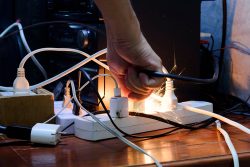How to Teach Your Kids About Electrical Safety
May 28, 2023 5:40 pm Leave your thoughts How to Teach Your Kids About Electrical Safety
How to Teach Your Kids About Electrical Safety
As parents, it is crucial to teach our children about electrical safety. Electricity is an essential part of our daily lives, but it can also be dangerous if not handled properly. It’s important to ensure that our kids understand the hazards associated with electricity and learn how to use it safely. Here are some useful tips on how to teach your kids about electrical safety:
1. Start with the basics
The first step in teaching your kids about electrical safety is to start with the basics. Begin by explaining to them what electricity is and how it works. Use simple language and examples that they can easily understand.
You can say something like, “Electricity is the flow of energy through wires. It powers our lights, TVs, and many other things we use every day. But we need to be careful when we use it because it can be dangerous.”
2. Go over the dangers
Next, go over the dangers associated with electricity. Explain that electricity can cause shocks, burns, and even death if not used properly. Tell them that they should never touch electrical outlets, cords, or appliances with wet hands or when they’re standing in water.
You can also demonstrate the dangers of electricity by using visual aids such as pictures or videos. Show them what happens when someone touches a live wire or sticks something metal into an electrical outlet.
3. Teach them how to use electrical appliances
Once your kids have a basic understanding of electricity and its dangers, it’s time to teach them how to use electrical appliances safely. Show them how to properly plug in and unplug cords and appliances. Teach them to never yank on cords or pull them out of the wall by the cord.
Make sure they know how to turn appliances on and off, and that they should never touch them if they are wet or if they’re not wearing shoes.
4. Teach them to be careful around water
Water and electricity don’t mix, so teach your kids to be extra careful when using electrical appliances around water. Warn them against using hairdryers, radios, or other electrical devices while they’re in the bathtub, shower, or swimming pool.
Teach them to never touch electrical devices if their hands are wet, and to make sure they’re standing on dry ground when using electrical appliances outside.
5. Show them how to respond to an emergency
It’s important for kids to know what to do in case of an electrical emergency. Teach them to immediately turn off the power at the main switch if they see someone in contact with a live wire or are experiencing an electric shock.
Tell them to never try to touch or move someone who is being electrocuted, but to call 911 instead. Show them where the emergency contact information is, and make sure they know how to call for help if needed.
6. Lead by example
The best way to teach your kids about electrical safety is to lead by example. Make sure that you follow all of the safety rules that you’re teaching them about. Don’t overload electrical outlets, and don’t leave electrical appliances unattended.
Show them how to properly coil cords and put away appliances when they’re not being used. By demonstrating good electrical safety habits, you’re helping to reinforce the importance of being careful around electricity.
Conclusion
Teaching your kids about electrical safety is an essential part of keeping them safe. Start by explaining the basics of electricity and its dangers. Teach them how to use electrical appliances safely, and warn them of the hazards of water and electricity.
Show them how to respond to an emergency, and lead by example by following all of the safety rules that you’re teaching them about. By taking these steps, you’ll help to keep your kids safe around electricity and empower them to make good decisions when using electrical appliances.
Categorised in: Electrical Safety Tips
This post was written by admin

 How to Teach Your Kids About Electrical Safety
How to Teach Your Kids About Electrical Safety